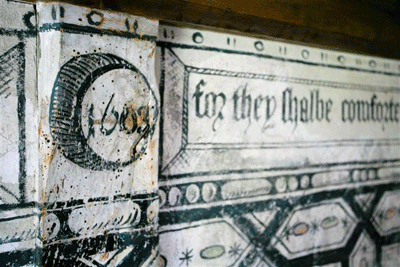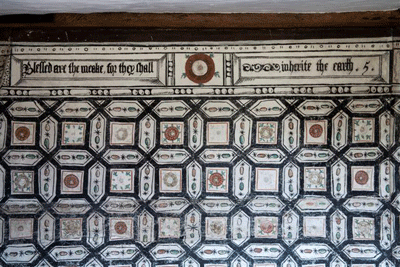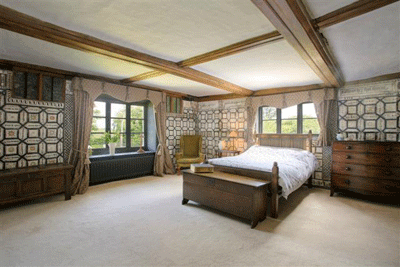Sleep in a Tudor room dedicated to a king
An extremely rare example of a Tudor painted bedroom is just one of the historic features of a wonderful house for sale in Kent

I have recently been delving into the history of a very unique home for sale near Canterbury in Kent. It features a rare example of a Tudor painted room inspired by James I’s accession to the throne in 1603. Not only can you sleep in a room painted in the 1600s, but the whole house has been lovingly restored and also features an original Tudor staircase and timber roof of a 15th century great hall.
The ornate Tudor artwork in Paramour Grange is one of the few examples of this kind to be found in a residential home. It features heraldic colours with bold octagonal design, featuring images of roses, asterisks and ovals. One of the key features is the top frieze which is inscribed with verses from Mathew 5 from the Bible. The art work also features the symbols of the portcullis and the fleur-de-lys along with the date ‘1603’, as well as the letters I.R (James I) and P.H. (Prince Henry – James I eldest son who died in 1612).

Despite the remains of this unique art work, there is very little evidence to tell the story as to why it was painted in the house. Local historians have speculated that it could have been a chapel-at-ease, but it is commonly believed it was painted for the newly crowned James I, who visited Sandwich shortly after his coronation in 1603.

One of the reasons for the survival of the artwork in Paramour Grange is that at the time of the Civil War, 50 years later, it was covered over. This is perhaps understandable if a blatant allegiance to the King may put the residents in danger of recriminations. The decorative art work at Paramour Grange remained covered and was only discovered 250 years later, in 1915.

Very little is known about the early history of Paramour Grange, but it is believed that it originated as a medieval hall and was heavily rebuilt in the late 16th century. The first reference we find to Paramour Grange is when the prominent Kentish family of Paramour were associated with the house – giving the house its unique name. The Paramour family were living in the area during the 15th century, but it was the presence of Thomas Paramour, Mayor of Canterbury (1607-1619) that directly links the house with the family in the late 16th century. It is believed that it was Thomas who was responsible for the painted room.
The Paramour family continued in the house until the 1650s, supporting the idea that the art work was covered over when new residents moved in or because of events associated with the Civil War. By the 1690s we find Paramour Grange recorded in the land tax records occupied by a farmer, John Foatt. Paramour Grange then continued to be the home of farmers throughout the 18th and 19th centuries.
Today, the Grade II* listed Paramour Grange has been beautifully restored, highlighting the beautiful painted room, along with the Tudor staircase and many other historic features. The current owners even added a Jacobean-style knot garden to complete the picture of this historic home.
Exquisite houses, the beauty of Nature, and how to get the most from your life, straight to your inbox.
* More about Paramour Grange.
Country Life is unlike any other magazine: the only glossy weekly on the newsstand and the only magazine that has been guest-edited by His Majesty The King not once, but twice. It is a celebration of modern rural life and all its diverse joys and pleasures — that was first published in Queen Victoria's Diamond Jubilee year. Our eclectic mixture of witty and informative content — from the most up-to-date property news and commentary and a coveted glimpse inside some of the UK's best houses and gardens, to gardening, the arts and interior design, written by experts in their field — still cannot be found in print or online, anywhere else.
